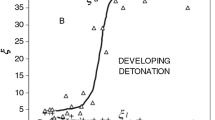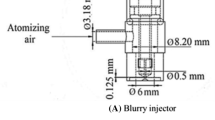Abstract
The aim of this study is to experimentally investigate the combustion regime transitions of a single-component kerosene surrogate (n-decane). For this purpose, a deflagration is generated by a spark in a constant-volume vessel with a length-to-width aspect ratio of 4.3. By consuming the unburnt gas, the flame behaves as a piston that compresses the end gas. The pressure and temperature of the end gas increase with the flame propagation until autoignition conditions are reached. Ultrafast schlieren visualizations are set up to monitor the dynamics of the reactive processes, whereas the time-pressure evolution associated with non-dimensional (0D) numerical models is used to characterize the unburnt gas thermodynamic conditions. Once the thermodynamic conditions needed to initiate the autoignition reactions are reached in the end gas, a transition between deflagration (flame speed of approximately ten m/s) and autoignition fronts is observed (propagation velocity ˜200 m/s). This transition occurs for various fuel equivalence ratio values (0.75 – 1). For the strongest thermodynamic conditions, once the velocity of this autoignition front reaches the speed of sound, a new reactive front propagating up to 1800 m/s is observed, thus indicating the transition to detonation combustion mode. Parametric studies indicated that the occurrence of both transitions was a function of the pressure, temperature and equivalence ratio for n-decane fuel. A small initial temperature variation (approximately 40 K) could change the phenomenology of the constant-volume combustion from deflagration to detonation through the autoignition process, even for lean mixtures. The results obtained using our experimental setup show that the transition between autoignition and detonation is due to the acceleration of the autoignition front towards the speed of sound in the unburnt gas.



















Similar content being viewed by others
References
European Commission: Flightpath 2050 Europe’s Vision for Aviation (2011)
Bellenoue, M., Boust, B., Vidal, P., Zitoun, R., Gaillard, T., Davidenko, D., Leyko, M., Le Naour, B.: New combustion concepts for propulsion engines. Aerospacelab 11, 1–13 (2016)
Akbari, P., Nalim, R., Mueller, N.: A review of wave rotor technology and its applications. J. Eng. Gas Turbines Power 128, 717–735 (2006)
Boust, B., Michalski, Q., Bellenoue, M.: Experimental investigation of ignition and combustion processes in a constant-Volume combustion chamber for air-breathing propulsion. AIAA propulsion and energy forum and exposition 2016, Salt Lake City, UTAH (2016)
Robert, A., Richard, S., Colin, O., Poinsot, T.: LES Study of deflagration to detonation mechanisms in a downsized spark ignition engine. Combustion and Flame 162, 2788–2807 (2015)
Bobusch, B.C., Berndt, P., Paschereit, C.O., Klein, R.: Shockless explosion combustion: an innovative way of efficient constant volume combustion in gas turbines. Combust. Sci. Technol. 186, 1680–1689 (2014)
Gu, X.J., Emerson, D.R., Bradley, D.: Modes of reaction front propagation from hot spots. Combustion and Flame 133, 63–74 (2003)
Bates, L., Bradley, D., Paczko, G., Peters, N.: Engine hot spots: Modes of auto-ignition and reaction propagation. Combustion and Flame 166, 80–85 (2016)
Kassoy, D.R.: The Zeldovich spontaneous reaction wave propagation concept in the fast/modest heating limits. J. Fluid Mech. 791, 439–463 (2016)
Zel’Dovich, Y.B.: Regime classification of an exothermic reaction with non-uniform initial conditions. Combustion and Flame 39, 211–214 (1980)
Grogan, K.P., Goldsborough, S.S., Ihme, M.: Ignition regimes in rapid compression machines. Combustion and Flame 162, 3071–3080 (2015)
Strozzi, C., Mura, A., Sotton, J., Bellenoue, M.: Experimental analysis of propagation regimes during the autoignition of a fully premixed methane-air mixture in the presence of temperature inhomogeneities. Combustion and Flame 159, 3323–3342 (2012)
Ben Houidi, M., Sotton, J., Bellenoue, M.: Interpretation of auto-ignition delays from RCM in the presence of temperature heterogeneities: impact on combustion regimes and negative temperature coefficient behaviour. Fuel 186, 476–485 (2016)
Zhang, P., Ji, W., He, T., He, X., Wang, Z., Yang, B.: First stage ignition delay in the negative temperature coefficient behaviour: experiment and simulation. Combustion and Flame 167, 14–23 (2016)
Qi, H.S., He, X., Zhang, P., Wang, Z., Wooldridge, M.S., Law, C.K.: Effect of buffer gas composition on low-temperature ignition of iso-octane and n-heptane. Combustion and Flame 161, 2531–2538 (2014)
Wang, Z., Qi, Y., Liu, H., Zhang, P., He, X., Wang, J.: Shock wave reflection induced detonation under high pressure and temperature condition in closed cylinder. Shockwave 26, 687–691 (2016)
Wang, Z., Qi, Y., He, X., Wang, J., Shuai, S.J., Law, C.K.: Analysis of pre-ignition to super-knock: hot spots induced deflagration to detonation. Fuel 144, 222–228 (2015)
Qi, Y., Wang, Z., Wang, J., He, X.: Effect of thermodynamic condition on the end gas combustion mode associated with engine knock. Combustion and Flame 162, 4119–4146 (2015)
Pan, J., Shu, G., Zhao, P., Wei, H., Chen, Z.: Interactions of flame propagation, auto-ignition and pressure wave during knocking combustion. Combustion and Flame. 164, 319–328 (2016)
Kumar, K., Mittal, G., Sung, C.J.: Autoignition of n-decane under elevated pressure and low to intermediate temperature conditions. Combustion and Flame 156, 1278–1288 (2009)
Le Dortz, R., Bellenoue, M., Sotton, J., Strozzi, C.: Effect of pressure and temperature on laminar burning velocity of a kerosene surrogate. 26th ICDERS, Boston, MA, USA July 30th – August 4th(2017)
Quintens, H., Strozzi, C., Zitoun, R., Bellenoue, M.: N-decane-air end-gas auto-ignition induced by flame propagation in a constant volume chamber: influence of the compression history ECM (2017)
Gallagher, S.M., Curran, H.J., Metcalfe, W.K., Healy, D., Simmie, J.M., Bourque, G.: A rapid compression machine study of the oxidation of propane in the negative temperature coefficient. Combustion and Flame 153, 316–333 (2008)
Westbrook, C.K., Pitz, W.J., Herbinet, O., Curran, H.J., Silke, E.J.: A comprehensive detailed chemical kinetic reaction mechanism for combustion of n-alkane hydrocarbons from n-octane to n-hexadecane. Combustion and Flame 156, 181–199 (2009)
Boulal, S., Vidal, P., Zitoun, R., Luche, J.: The sensitivity of chemical kinetics with two characteristic lengths of homogeneous gases. International Journal of Energetic Materials and Chemical Propulsion 14, 499–517 (2015)
Dunn-Rankin, D., Sawyer, R.F.: Tulip flames: changes in shape of premixed flames propagating in closed tubes. Experiments in Fluids 24(2), 130–140 (1998)
Jarosinski, J., Veyssiere, B.: Combustion phenomena: selected mechanisms of flame formation propagation and extinctions, p 220. CRC Press Taylor &, Francis Group, Boca Raton (2009)
Claverie, A., Prevost, V., Sotton, J., Strozzi, C., Bellenoue, M.: Simultaneous PLIF imaging of formaldehyde within a rapid compression machine. In: 17th international symposium of laser techniques to fluid mechanics (2014)
Bradley, D., Kalgatgi, G.T.: Influence of autoignition delay time characteristics of different fuels on pressure waves and knock in reciprocating engines. Combustion and Flame 156, 2307–2318 (2009)
Chen, J.H., Hawkes, E.R., Sankaran, R., Mason, S.D., Im, H.G.: Direct numerical simulation of ignition front propagation in a constant volume with temperature inhomogeneities: I. Fundamental analysis and diagnostics. Combustion and Flame 145, 128–144 (2006)
Xu, H., Yang, Z., Chaos, M., Dryer, F.L.: Surrogate jet fuel mixture formulation and development of experimental databases JANNAF 42nd Combustion Joint Sub-Committee Meeting (2008)
Acknowledgments
This work is part of the CAPA (Combustion Alternatives pour la Propulsion Aérobie) industrial Chair program, a research program on alternative combustion modes for air-breathing propulsion supported by SAFRAN, MBDA France and the Agence Nationale de la Recherche. The authors gratefully acknowledge Alain Claverie for his help with the optical diagnostics and Dr Pierre Vidal and Dr Florent Virot for their help with the detonation numerical simulations.
Author information
Authors and Affiliations
Corresponding author
Ethics declarations
Conflict of interests
Hugo Quintens has received grant research from the CAPA Chair (joint research program between SAFRAN, MBDA and ANR). The authors declare that they have no conflicts of interest.
Additional information
Publisher’s Note
Springer Nature remains neutral with regard to jurisdictional claims in published maps and institutional affiliations.
Rights and permissions
About this article
Cite this article
Quintens, H., Strozzi, C., Zitoun, R. et al. Deflagration/Autoignition/Detonation Transition Induced by Flame Propagation in an N-Decane/O2 /Ar Mixture. Flow Turbulence Combust 102, 735–755 (2019). https://doi.org/10.1007/s10494-018-9980-9
Received:
Accepted:
Published:
Issue Date:
DOI: https://doi.org/10.1007/s10494-018-9980-9




